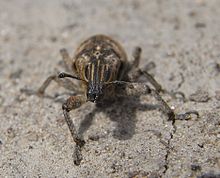Thistle gall weevil
| Thistle gall weevil | ||||||||||||
|---|---|---|---|---|---|---|---|---|---|---|---|---|

Thistle gall weevil |
||||||||||||
| Systematics | ||||||||||||
|
||||||||||||
| Scientific name | ||||||||||||
| Cleonis pigra | ||||||||||||
| ( Scopoli , 1763) |
The thistle gall weevil ( Cleonis pigra , formerly mistakenly piger ) is a beetle from the family of weevils and the subfamily Lixinae . The scientific generic name Cleonis is from Altgr. κλέος kléos derived from "fame". The species name piger ( lat. ) Means "slowly". The German name "thistle gall weevil" can be explained by the fact that the larvae feed on the thistle roots causes gall formation.
Characteristics of the beetle
The chunky-looking black body is covered with white-gray woolly hair. The washed-out markings on the pronotum and elytra can be traced back to the different thicknesses of hair and the different intensities of the dark body color. The more the hair is worn, the darker the beetle appears. The body length varies between ten and sixteen millimeters.
The mouthparts lie on an extension of the head forward, the trunk. The trunk is angular and flattened on the top. It's longer than the rest of the head. On the upper side of the trunk has three longitudinal furrows, of which the middle one reaches the pronotum. The longitudinal furrows are lightly haired and separated by keels, the lateral longitudinal furrows are also bounded on the outside by a keel. So there are four keels and three grooves visible from above. The feeler rises under the side keel , the base of which can be inserted into a groove-like groove running downwards at 45 degrees. This antenna groove cannot be seen from above and reaches the underside of the trunk well in front of the eyes.
The kneeled antennae consist of a shaft that is thickened on the outside with a strongly clumpy shape and hardly reaches the front edge of the eye. This is followed by a thick, seven-limbed flagellum, which is followed by a tightly knit and long oval club. The first limb is longer than the second. The round eyes are on the side of the head, are slightly arched, oval, and much higher than wide.
The pronotum has two more or less distinct light-colored longitudinal bands on each side, a wider one lying on top of the side and parallel to it further inside a narrower one, which arises approximately at the level of the outer keels of the trunk. The front edge of the pronotum expands laterally in the lower area to the front (eye lobe). The pronotum is usually keeled, the keel pressed a little broad in front of the middle. Like the base of the wing, the pronotum is covered with shiny granules.
On each wing there are three, often indistinct, dark oblique bands that run at about 45 ° from the front outside to the back inside towards the seam . The label is small but clearly visible.
The strong legs have four-limbed tarsi. The three tarsi are short, the first the longest, the other two about the same length.
biology
The larvae develop in the root neck of various thistle plants ( nodding thistle , path thistle , common scraper , field scraper , cabbage thistle , donkey thistle , milk thistle , woolly scraper ) as well as large and small burdock . Beetles have also been raised from the root galls of various species of knapweed ( Centaurea maculosa , Centaurea diffusa , Centaurea arenaria ). However, the main host is the field thistle.
Adults can be found all year round, the new generation appears in August. The adults overwinter. In the following year, the females lay their eggs in the root neck , the lower stem area or even in the base of the midrib of the leaves from mid-April to the end of June . The larvae eat their way down into the roots. The root develops a spindle-shaped bile around the place where it has been eaten. Pupation takes place in the root.
Depending on the range of host plants, the beetle can be found more often, but not exclusively, in warmer and drier habitats .
distribution
The Palearctic species occurs almost everywhere in Europe except in the northern parts of Scandinavia and is the most common species of the tribe . In the south it can also be found in North Africa, to the east the distribution area extends over Siberia , Mongolia and China to the Pacific .
The beetle is also reported from North America .
literature
- Heinz joy , Karl Wilhelm Harde , Gustav Adolf Lohse (ed.): The beetles of Central Europe . tape 11 . Rhynchophora (end). Goecke & Evers, Krefeld 1983, ISBN 3-87263-031-8 .
Individual evidence
- ↑ a b Cleonis pigra at Fauna Europaea. Retrieved January 31, 2011
- ↑ Siegmund Schenkling, "Explanation of the Scientific Beetle Names"
- ↑ a b Anderson DM "Notes on Cleonus piger in the United States" Coleopterists Bulletin 10: 81-85 quoted in Invasive Plants of the Eastern US: Canada Thistle ( Memento of the original from February 25, 2012 in the Internet Archive ) Info: The archive link was used automatically and not yet checked. Please check the original and archive link according to the instructions and then remove this notice.
- ↑ a b Polish coleopterological website
Web links
- Skuhrovec, J .; Volovnik, S .; Gosik, R .; Stejskal; R. Trnka, F. (2019): Cleonis pigra (Scopoli, 1763) (Coleoptera: Curculionidae: Lixinae): Morphological Re-Description of the Immature Stages, Keys, Tribal Comparisons and Biology. Insects 10 (9): 325 (1-25) PDF

